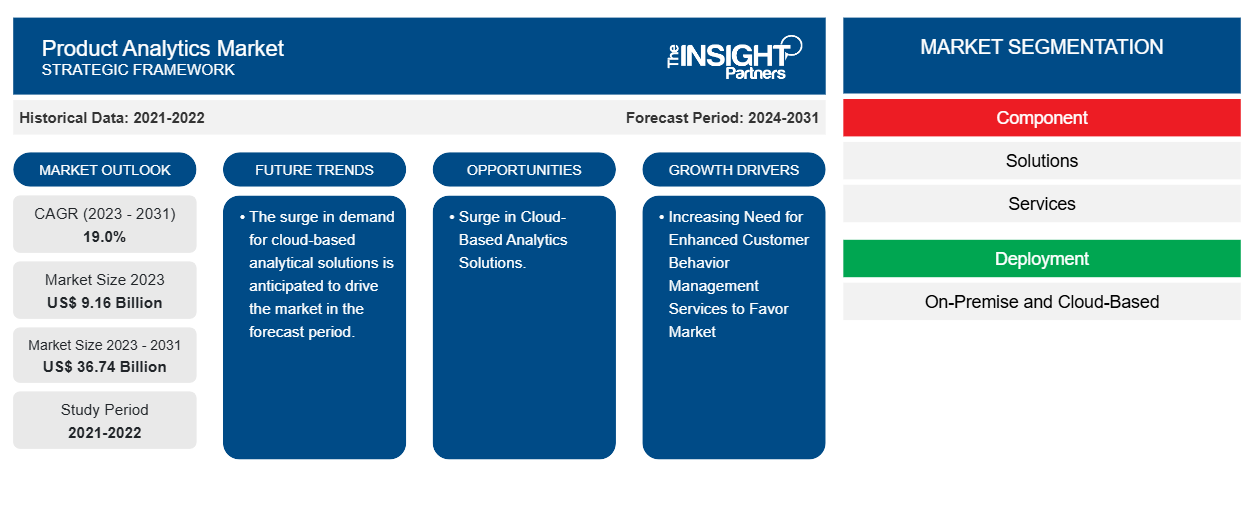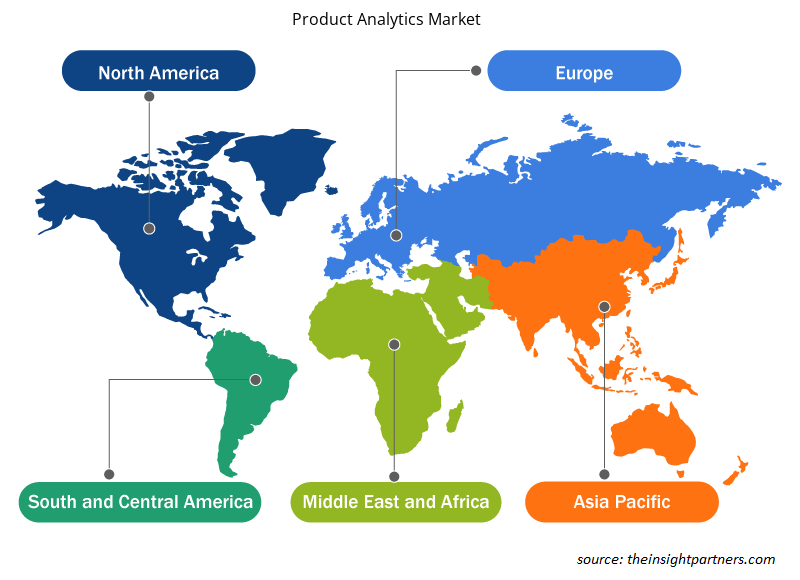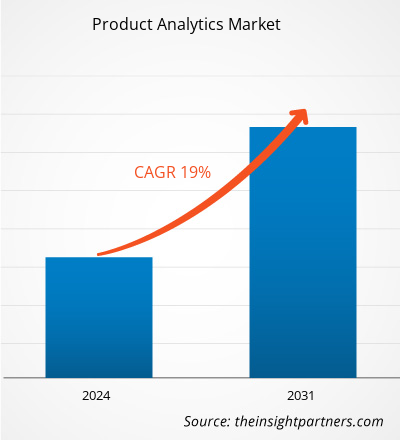The product analytics market size is projected to reach US$ 36.74 billion by 2031 from US$ 9.16 billion in 2023. The market is expected to register a CAGR of 19.0% during 2023–2031. The increasing need for enhanced customer behavior management services and the rise in the usage of advanced technologies are likely to be the key drivers and trends of the market.
Product Analytics Market Analysis
The product analytics market is experiencing significant growth globally. This growth is attributed to factors such as the increasing need for enhanced customer behavior management services and the rise in usage of advanced technologies. Moreover, the surge in demand for cloud-based analytical solutions is anticipated to hold several opportunities for the product analytic market.
Product Analytics Market Overview
Product analytics is the method of analyzing how users retain with a product or service. It enables product teams to analyze, track, visualize, user engagement and behavior data. Teams use this data to optimize and improve a product or service.
Customize This Report To Suit Your Requirement
You will get customization on any report - free of charge - including parts of this report, or country-level analysis, Excel Data pack, as well as avail great offers and discounts for start-ups & universities
Product Analytics Market: Strategic Insights

- Get Top Key Market Trends of this report.This FREE sample will include data analysis, ranging from market trends to estimates and forecasts.
You will get customization on any report - free of charge - including parts of this report, or country-level analysis, Excel Data pack, as well as avail great offers and discounts for start-ups & universities
Product Analytics Market: Strategic Insights

- Get Top Key Market Trends of this report.This FREE sample will include data analysis, ranging from market trends to estimates and forecasts.
Product Analytics Market Drivers and Opportunities
Increasing Need for Enhanced Customer Behavior Management Services to Favor Market
The increasing need for enhanced customer behavior management services is indeed driving the product analytics market as several businesses understand individual customer preferences and behaviors to customize personalized experiences. Several companies in the market offer product analytics for enhanced customer behavior. For instance, in March 2023, Adobe unveiled new Adobe Product Analytics in Adobe Experience Cloud. The new application reimagines the product analytics category by unifying customer journey insights across marketing and products. For the first time, teams focused on customer experiences can benefit from a truly unified view of the customer and collaborate seamlessly across an organization, driving profitable growth as a result.
Surge in Cloud-Based Analytics Solutions.
A surge in solutions cloud-based analytics solutions can drive the product analytics market in several ways. As cloud-based solutions offer scalability, allowing businesses to easily adjust their analytics capabilities based on demand. Furthermore, many companies offer cloud-based analytics solutions. For example, SAP Analytics Cloud solution, part of SAP Business Technology Platform many companies are empowering people of all ranks and skill sets to make decisions that lead to consequential outcomes for their business and community.
Product Analytics Market Report Segmentation Analysis
Key segments that contributed to the derivation of the product analytics market analysis are component, deployment, mode, and vertical.
- Based on components, the product analytics market is divided into solutions and services. The solutions segment is anticipated to hold a significant market share in the forecast period.
- Based on deployment, the product analytics market is divided into tracking data and analyzing data. The tracking data segment is anticipated to hold a significant market share in the forecast period.
- By vertical, the market is segmented into retail and consumer goods, food and beverages, healthcare and pharmaceuticals, energy and utilities, automotive, manufacturing, and others. Retail and consumer goods are anticipated to hold a significant market share in the forecast period.
Product Analytics Market Share Analysis by Geography
The geographic scope of the product analytics market report is mainly divided into five regions: North America, Asia Pacific, Europe, Middle East & Africa, and South & Central America.
North America has dominated the product analytics market. High technology adoption trends in various industries in the North American region have fuelled the growth of the product analytics market. Factors such as increased adoption of digital tools and high technological spending by government agencies are expected to drive the North American product analytics market growth. Moreover, a strong emphasis on research and development in the developed economies of the US and Canada is forcing the North American players to bring technologically advanced solutions into the market. In addition, the US has a large number of product analytics market players who have been increasingly focusing on developing innovative solutions. All these factors contribute to the region's growth of the product analytics market.
Product Analytics Market Regional Insights
The regional trends and factors influencing the Product Analytics Market throughout the forecast period have been thoroughly explained by the analysts at The Insight Partners. This section also discusses Product Analytics Market segments and geography across North America, Europe, Asia Pacific, Middle East and Africa, and South and Central America.

- Get the Regional Specific Data for Product Analytics Market
Product Analytics Market Report Scope
| Report Attribute | Details |
|---|---|
| Market size in 2023 | US$ 9.16 Billion |
| Market Size by 2031 | US$ 36.74 Billion |
| Global CAGR (2023 - 2031) | 19.0% |
| Historical Data | 2021-2022 |
| Forecast period | 2024-2031 |
| Segments Covered |
By Component
|
| Regions and Countries Covered | North America
|
| Market leaders and key company profiles |
Product Analytics Market Players Density: Understanding Its Impact on Business Dynamics
The Product Analytics Market is growing rapidly, driven by increasing end-user demand due to factors such as evolving consumer preferences, technological advancements, and greater awareness of the product's benefits. As demand rises, businesses are expanding their offerings, innovating to meet consumer needs, and capitalizing on emerging trends, which further fuels market growth.
Market players density refers to the distribution of firms or companies operating within a particular market or industry. It indicates how many competitors (market players) are present in a given market space relative to its size or total market value.
Major Companies operating in the Product Analytics Market are:
- Amplitude, Inc.
- Gainsight
- Heap Inc.
- IBM Corporation
- Mixpanel
- Pendo.io, Inc.
Disclaimer: The companies listed above are not ranked in any particular order.

- Get the Product Analytics Market top key players overview
Product Analytics Market News and Recent Developments
The product analytics market is evaluated by gathering qualitative and quantitative data post primary and secondary research, which includes important corporate publications, association data, and databases. A few of the developments in the product analytics market are listed below:
- Instructure, the leading learning technology ecosystem and maker of Canvas LMS, launched Intelligent Insights, a new product powered by AI and analytics, unlocking a level of self-service reporting capabilities generally unavailable to educational institutions. (Source: Instructure Company Website, June 2024)
- LSEG (London Stock Exchange Group) and Dow Jones announced a new, multi-year data, news, and analytics partnership. Dow Jones to embed LSEG’s world-class data and analytics capabilities across digital and print properties, including The Wall Street Journal, Barron's, Investor’s Business Daily and MarketWatch. (Source: LSEG Company Website, July 2024)
Product Analytics Market Report Coverage and Deliverables
The “Product Analytics Market Size and Forecast (2021–2031)” report provides a detailed analysis of the market covering below areas:
- Product analytics market size and forecast at global, regional, and country levels for all the key market segments covered under the scope.
- Product analytics market trends as well as market dynamics such as drivers, restraints, and key opportunities.
- Detailed PEST/Porter’s Five Forces and SWOT analysis.
- Product analytics market analysis covering key market trends, global and regional framework, major players, regulations, and recent market developments.
- Industry landscape and competition analysis covering market concentration, heat map analysis, prominent players, and recent developments for the product analytics market.
- Detailed company profiles.
Frequently Asked Questions
What would be the estimated value of the product analytics market by 2031?
The global product analytics market is expected to reach US$ 36.74 billion by 2031.
Which are the leading players operating in the product analytics market?
The key players holding majority shares in the global product analytics market are Amplitude, Inc., Gainsight, Heap Inc., IBM Corporation, Mixpanel, Pendo.io, Inc., LogRocket, Inc, Smartlook, USERIQ, KISSMETRICS.
What are the future trends of the product analytics market?
The surge in demand for cloud-based analytical solutions is anticipated to drive the market in the forecast period.
What are the driving factors impacting the product analytics market?
The increasing need for enhanced customer behavior management services and the rise in usage of advanced technologies are some of the factors driving the product analytics market.
Which region dominated the product analytics market in 2023?
North America is anticipated to dominate the product analytics market in 2023.
What is the expected CAGR of the product analytics market?
The expected CAGR of the product analytics market is 19.0%.
- Historical Analysis (2 Years), Base Year, Forecast (7 Years) with CAGR
- PEST and SWOT Analysis
- Market Size Value / Volume - Global, Regional, Country
- Industry and Competitive Landscape
- Excel Dataset
- Parking Meter Apps Market
- eSIM Market
- Advanced Distributed Management System Market
- Online Exam Proctoring Market
- Electronic Data Interchange Market
- Barcode Software Market
- Maritime Analytics Market
- Cloud Manufacturing Execution System (MES) Market
- Robotic Process Automation Market
- Digital Signature Market
Testimonials
Reason to Buy
- Informed Decision-Making
- Understanding Market Dynamics
- Competitive Analysis
- Identifying Emerging Markets
- Customer Insights
- Market Forecasts
- Risk Mitigation
- Boosting Operational Efficiency
- Strategic Planning
- Investment Justification
- Tracking Industry Innovations
- Aligning with Regulatory Trends
Yes! We provide a free sample of the report, which includes Report Scope (Table of Contents), report structure, and selected insights to help you assess the value of the full report. Please click on the "Download Sample" button or contact us to receive your copy.
Absolutely — analyst assistance is part of the package. You can connect with our analyst post-purchase to clarify report insights, methodology or discuss how the findings apply to your business needs.
Once your order is successfully placed, you will receive a confirmation email along with your invoice.
• For published reports: You’ll receive access to the report within 4–6 working hours via a secured email sent to your email.
• For upcoming reports: Your order will be recorded as a pre-booking. Our team will share the estimated release date and keep you informed of any updates. As soon as the report is published, it will be delivered to your registered email.
We offer customization options to align the report with your specific objectives. Whether you need deeper insights into a particular region, industry segment, competitor analysis, or data cut, our research team can tailor the report accordingly. Please share your requirements with us, and we’ll be happy to provide a customized proposal or scope.
The report is available in either PDF format or as an Excel dataset, depending on the license you choose.
The PDF version provides the full analysis and visuals in a ready-to-read format. The Excel dataset includes all underlying data tables for easy manipulation and further analysis.
Please review the license options at checkout or contact us to confirm which formats are included with your purchase.
Our payment process is fully secure and PCI-DSS compliant.
We use trusted and encrypted payment gateways to ensure that all transactions are protected with industry-standard SSL encryption. Your payment details are never stored on our servers and are handled securely by certified third-party processors.
You can make your purchase with confidence, knowing your personal and financial information is safe with us.
Yes, we do offer special pricing for bulk purchases.
If you're interested in purchasing multiple reports, we’re happy to provide a customized bundle offer or volume-based discount tailored to your needs. Please contact our sales team with the list of reports you’re considering, and we’ll share a personalized quote.
Yes, absolutely.
Our team is available to help you make an informed decision. Whether you have questions about the report’s scope, methodology, customization options, or which license suits you best, we’re here to assist. Please reach out to us at sales@theinsightpartners.com, and one of our representatives will get in touch promptly.
Yes, a billing invoice will be automatically generated and sent to your registered email upon successful completion of your purchase.
If you need the invoice in a specific format or require additional details (such as company name, GST, or VAT information), feel free to contact us, and we’ll be happy to assist.
Yes, certainly.
If you encounter any difficulties accessing or receiving your report, our support team is ready to assist you. Simply reach out to us via email or live chat with your order information, and we’ll ensure the issue is resolved quickly so you can access your report without interruption.





















 Get Free Sample For
Get Free Sample For